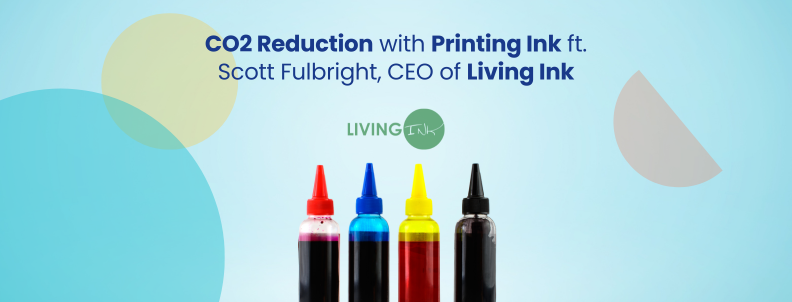With governments enforcing stricter regulations and consumers demanding greater sustainability, businesses are being pushed to limit their carbon impact. As a result, industries are adopting alternatives to various processes of their production that lead to GHG emissions. One such process is the use of carbon printing inks.
While discovering efficient carbon reduction technology remains challenging, we found some startups that are actively using eco-friendly inks. One such startup is Living Ink.
The startup aims to provide a sustainable, safe alternative to carbon black pigments. To achieve this, they have developed a process that uses algae-derived pigments to create eco-friendly printer inks.
As a technology scouting firm, we were determined to uncover the science behind Living Ink’s technology and explore its potential impact on carbon reduction. So we invited Scott, the CEO of Living Ink, to share valuable insights into their carbon footprint reduction process.

Scott Fulbright is the CEO and Co-founder of Living Ink, a renowned technology company specializing in eco-friendly printing inks that help reduce carbon footprint. He’s an innovative entrepreneur, utilizing biotechnology to craft sustainable materials, including a carbon-negative bio-based black replacement.
Want to know how Living Ink is doing it? See for yourself.
Overview: Living Ink’s Carbon Reducing Ink
Living Ink Technology claims its ink is climate positive, with 45 pounds of its product capable of removing 59 kg of CO2 from the environment when produced industrially. This amount is equivalent to negating the use of 22.5 pounds of petroleum.
When compared with its traditional counterparts, they claim that the ink can be stored and used without modification.
The company sources its biomass from Earthrise Nutritionals in California, where spirulina, a type of algae, is grown from natural food colorants.
After extracting the colorant, the remaining algae waste biomass is processed and purified using a proprietary method to create a black pigment. This purified content is then milled to form a dispersion that can generate ink.
The video further elaborates on the Living Ink technology and its impact on the reduction of Carbon along with the company’s vision.
Short on time?
Here are key highlights from the discussion.
Highlights from the conversation
Which application areas are you targeting or planning to target?
If you take a look around your office, items like phone cases, headphones, and even plastic pen bodies—anything black—is often derived from carbon black, sourced from petroleum or oil.
Our solution involves transitioning away from finite resources like petroleum. We can create a wide array of products, including plastics, rubbers, foams, leather goods, and even inks on shirts or packages. At a higher level, we are a carbon-negative company specializing in carbon black pigments. Our primary focus centers on ink production, allowing us to produce versatile black ink used in everything from packages and books to shirts and shoes.
Have you encountered any roadblocks when it comes to the regulatory aspects of the markets you’re currently working in?
Absolutely, we’re currently focused on the cosmetic sector, an area subject to strict regulations. We’re actively collaborating with various companies in the food industry, which includes both direct and indirect contact with food and thus involves regulations.
We’re beginning to go down that road. The regulatory and compliance aspects are minimal when we print on items like shoe boxes. Thus, our initial focus is on these markets. However, the present time marks our journey toward tackling the regulatory challenges associated with sectors like food packaging
When it came to commercialization, what challenges did you encounter?
Certainly, for startups like Living Ink that are focused on materials, there’s a bit of a chicken-and-egg scenario at play. We require substantial contracts and commitments, yet major entities like prominent automotive companies are hesitant until we’ve validated full scalability and reached price parity.
Currently, we’re exploring several avenues to navigate this challenge, which is quite exciting for us. However, one of the most significant hurdles remains achieving price parity within the petrochemical industry. Simultaneously, we need to rapidly and systematically scale our operations to fulfill all the potential we promise. So, indeed, this stands out as a major challenge for us.
How does your company differentiate itself from other companies pursuing similar paths?
Indeed, there are a couple of other companies pursuing similar paths, although not necessarily with the same origin story or starting materials. When considering these situations, I always emphasize the enormity of the markets we’re dealing with.
There’s ample room to repurpose various waste products from diverse sources into valuable materials that hold the potential to make a significant impact. While there’s some competition when vying for brands and potential investments, I see these groups more as collaborators. Together, we’re aiming to tackle a fraction of the expansive market landscape.
Furthermore, there are billion-dollar corporations that often speak about sustainability, but their approach to innovation appears to be incremental. In contrast, our innovation represents a monumental leap, an entirely distinct story from what they’re accustomed to. The term “sustainability” is frequently thrown around, but it’s crucial to communicate to brands how fundamentally different our approach is.
Interested to know which other startups are working on eco-friendly inks? Read our complete article.
Meet Our Interviewer – Vikas Jha, AVP, Solutions at GreyB

Vikas Jha is an experienced tech consultant focusing on Intellectual Property Consulting. With expertise in diverse domains like Telecom, Navigation, and Medical Devices, he helps clients navigate innovation challenges. His ability to bridge technology, innovation, and leadership makes him a valuable resource in the evolving tech landscape. Vikas has been featured on CNBC for his insights on next-gen technologies like space tech.
Want to scout other innovative technologies for reducing your carbon footprint?
Let us help you out.
Authored By – Ridhima Mahajan, Marketing
Next Read: 8 Mineral Oil-Free Ink Companies Complying with EU Standards for Food Packaging











